Mycenaean Art
“I have gazed into the face of Agamemnon.” Schliemann
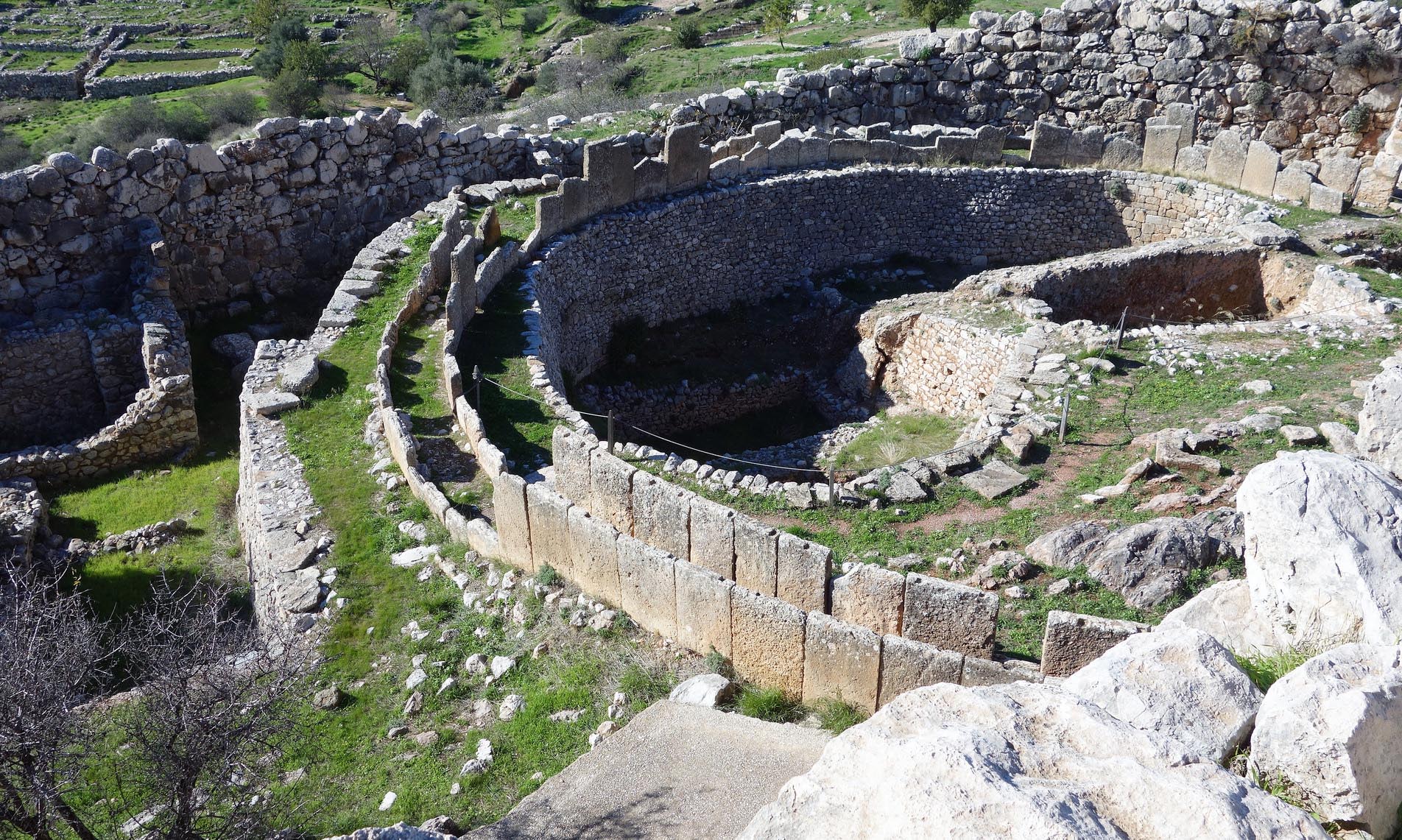
The architecture of Mycenaean citadel sites reflects the war-like culture and its constant need for protection and fortification.
Mycenaean culture can be summarized by its architecture, whose remains demonstrate the Mycenaeans’ war-like culture and the dominance of citadel sites ruled by a single ruler. The Mycenaeans populated Greece and built citadels on high, rocky outcroppings that provided natural fortification and overlooked the plains used for farming and raising livestock. The citadels vary from city to city but each shares common attributes, including building techniques and architectural features.
By the end of this module you will be able to:
- Identify and describe the form, content, and context of Mycenaean works
- Define the critical terms related to Mycenaean art
- Describe the Mycenaean architecture and funerary practices
Building Techniques
The walls of Mycenaean citadel sites were often built with ashlar and massive stone blocks. The blocks were considered too large to be moved by humans and were believed by ancient Greeks to have been erected by the Cyclopes—one-eyed giants. Due to this ancient belief, the use of large, roughly cut, ashlar blocks in buildings are referred to as Cyclopean masonry. The thick Cyclopean walls reflect a need for protection and self-defence since these walls often encircled the citadel site and the acropolis on which the site was located.
Corbel Arch
The Mycenaeans also relied on new techniques of building to create supportive archways and vaults. A typical post and lintel structure is not strong enough to support the heavy structures built above it. Therefore, a corbeled (or corbel) arch is employed over doorways to relieve the weight on the lintel.
The corbel arch is constructed by offsetting (cantilevering) successive courses of stone (or brick) at the spring line of the walls so that they project towards the archway’s center from each supporting side until the courses meet at the apex of the archway (often, the last gap is bridged with a flat stone). The corbel arch was often used by the Mycenaeans in conjunction with a relieving triangle, which was a triangular block of stone that fits into the recess of the corbeled arch and helped to redistribute weight from the lintel to the supporting walls. The triangular space may have been left open in some structures.
![By User:Alexikoua, User:Panthera tigris tigris, TL User:Reedside - Ιστορία του Ελληνικού Έθνους, Εκδοτική Αθηνών, τ. Α' χάρτες σε σελ. 263-265, σελ. 290, 292-293 (επίσης [1], CC BY-SA 3.0, https://commons.wikimedia.org/w/index.php?curid=61505445](https://pressbooks.bccampus.ca/alenabuis/wp-content/uploads/sites/1143/2020/09/Picture1-1.png)
Citadel Sites
Mycenaean citadel sites were centred around the megaron, a reception area for the king. The megaron was a rectangular hall, fronted by an open, two-columned porch. It contained a more or less central open hearth, which was vented through an oculus in the roof above it and surrounded by four columns. The architectural plan of the megaron became the basic shape of Greek temples, demonstrating the cultural shift as the gods of ancient Greece took the place of the Mycenaean rulers.
Citadel sites were protected from invasion through natural and man-made fortification. In addition to thick walls, the sites were protected by controlled access. Entrance to the site was through one or two large gates, and the pathway into the main part of the citadel was often controlled by more gates or narrow passageways. Since citadels had to protect the area’s people in times of warfare, the sites were equipped for sieges. Deepwater wells, storage rooms, and open space for livestock and additional citizens allowed a city to access basic needs while being protected during times of war.
Mycenae
The citadel site of Mycenae was the center of Mycenaean culture. It overlooks the Argos plain on the Peloponnesian peninsula, and according to Greek mythology was the home to King Agamemnon.
The site’s megaron sits on the highest part of the acropolis and is reached through a large staircase. Inside the walls are various rooms for administration and storage along with palace quarters, living spaces, and temples. A large gravesite, known as Grave Circle A, is also built within the walls.
The main approach to the citadel is through the Lion Gate, a cyclopean-walled entranceway. The gate is 20 feet wide, which is large enough for citizens and wagons to pass through, but its size and the walls on either side create a tunnelling effect that makes it difficult for an invading army to penetrate.
The gate is famous for its use of the relieving arch, a corbeled arch that leaves an opening and lightens the weight carried by the lintel. The Lion Gate received its name from its decorated relieving triangle of lions on either side of a single column. This composition of lions or another feline animal flanking a single object is known as a heraldic composition. The lions represent cultural influences from the Ancient Near East. Their heads are turned to face outwards and confront those who enter the gate.
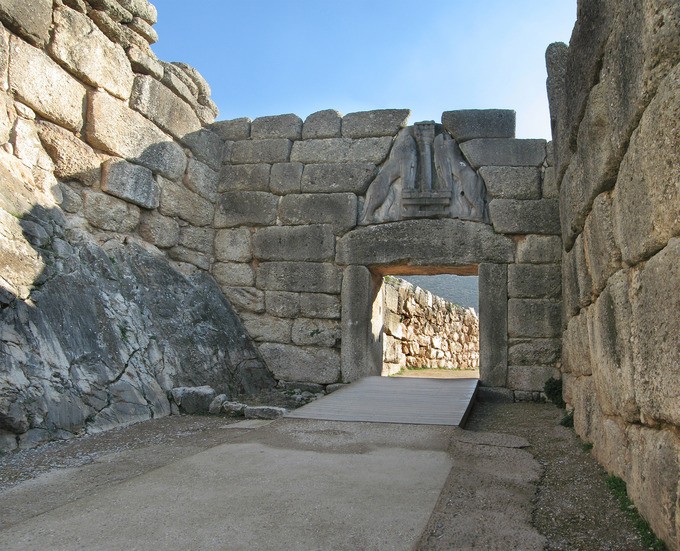
Mycenae is also home to a subterranean beehive-shaped tomb (also known as a tholos tomb) that was located outside the citadel walls. The tomb is known today as the Treasury of Atreus, due to the wealth of grave goods found there. This tomb and others like it are demonstrations of corbeled vaulting that covers an expansive open space. The vault is 44 feet high and 48 feet in diameter. The tombs are entered through a narrow passageway known as a dromos and a post-and-lintel doorway topped by a relieving triangle.
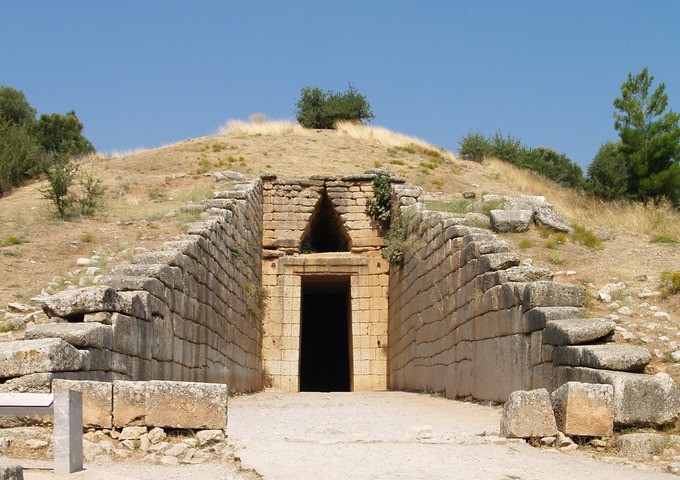
Tiryns
The citadel site of Tiryns, another example of Mycenaean fortification, was a hill fort that has been occupied over the course of 7000 years. It reached its height between 1400 and 1200 BCE when it was one of the most important centers of the Mycenaean world. Its most notable features were its palace, its Cyclopean tunnels, its walls, and its tightly controlled access to the megaron and main rooms of the citadel.
Just a few gates provide access to the hill but only one path leads to the main site. This path is narrow and protected by a series of gates that could be opened and closed to trap invaders. The central megaron is easy to locate, and it is surrounded by various palatial and administrative rooms. The megaron is accessed through a courtyard that is decorated on three sides with a colonnade.

The famous megaron has a large reception hall, the main room of which had a throne placed against the right wall and a central hearth bordered by four wooden columns that served as supports for the roof. It was laid out around a circular hearth surrounded by four columns. Although individual citadel sites varied to a degree, their overall uniformity allows us to compare design elements easily. For example, the hearth of the megaron at the citadel of Pylos provides an idea of how its counterpart at Tiryns appears.
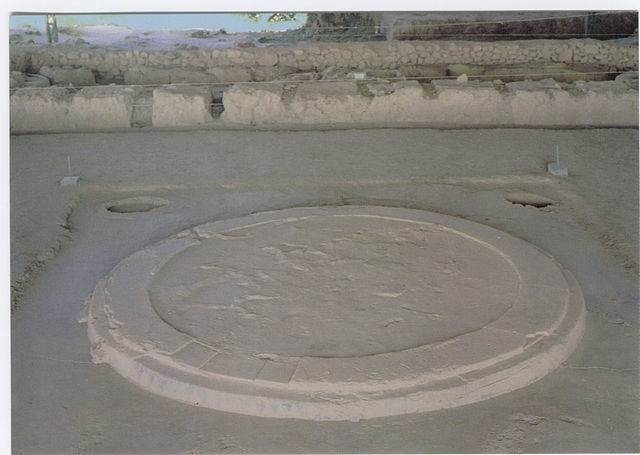
Mycenaean Metallurgy
The Mycenaeans were masterful metalworkers, as their gold, silver, and bronze daggers, drinking cups, and other objects demonstrate.
Grave Circle A at Mycenae
Grave Circle A is a set of graves from the sixteenth century BCE located at Mycenae. The grave circle was originally located outside the walls of the city but was later encompassed inside the walls of the citadel when the city’s walls were enlarged during the thirteenth century BCE.
The grave circle is surrounded by a second wall and only has one entrance. Inside are six tombs for nineteen bodies that were buried inside shaft graves. The shaft graves were deep, narrow shafts dug into the ground.
The body would be placed inside a stone coffin and placed at the bottom of the grave along with grave goods. The graves were often marked by a mound of earth above them and grave stele
The gravesite was excavated by Heinrich Schleimann in 1876 CE, who excavated ancient sites such as Mycenae and Troy based on the writings of Homer and was determined to find archaeological remains that aligned with observations discussed in the Iliad and the Odyssey. The archaeological methods of the nineteenth century were different than those of the twenty-first century and Schleimann’s desire to discover remains that aligned with mythologies and Homeric stories did not seem as unusual as it does today. Upon excavating the tombs, Schleimann declared that he found the remains of Agamemnon and many of his followers, a claim discounted by modern archaeology.
Grave Circle B
An additional grave circle, Grave Circle B, is also located at Mycenae, although this one was never incorporated into the citadel site. The two grave circles were elite burial grounds for the ruling dynasty. The graves were filled with precious items made from expensive material, including gold, silver, and bronze.
The amount of gold, silver, and precious materials in these tombs not only depict the wealth of the ruling class of the Mycenae but also demonstrates the talent and artistry of Mycenaean metalworking. Reoccurring themes and motifs underline the culture’s propensity for war and the cross-cultural connections that the Mycenaeans established with other Mediterranean cultures through trade, including the Minoans, Egyptians, and even the Orientalizing style of the Ancient Near East
Gold Death Masks
Repoussé death masks were found in many of the tombs. The death masks were created from thin sheets of gold, through a careful method of metalworking to create a low relief.
These objects are fragile, carefully crafted, and laid over the face of the dead. Schleimann called the most famous of the death masks the Mask of Agamemnon, under the assumption that this was the burial site of the Homeric king. The mask depicts a man with a triangular face, bushy eyebrows, a narrow nose, pursed lips, a mustache, and stylized ears.
This mask is an impressive and beautiful specimen but looks quite different from other death masks found at the site. The faces on other death masks are rounder; the eyes are more bulbous; at least one bears a hint of a smile. None of the other figures have a mustache or even a hint of a beard.
In fact, the mustache looks distinctly nineteenth century and is comparable to the mustache that Schleimann himself had. The artistic quality between the Mask of Agamemnon and the others seems dramatically different. Despite these differences, the Mask of Agamemnon has inserted itself into the story of Mycenaean art.
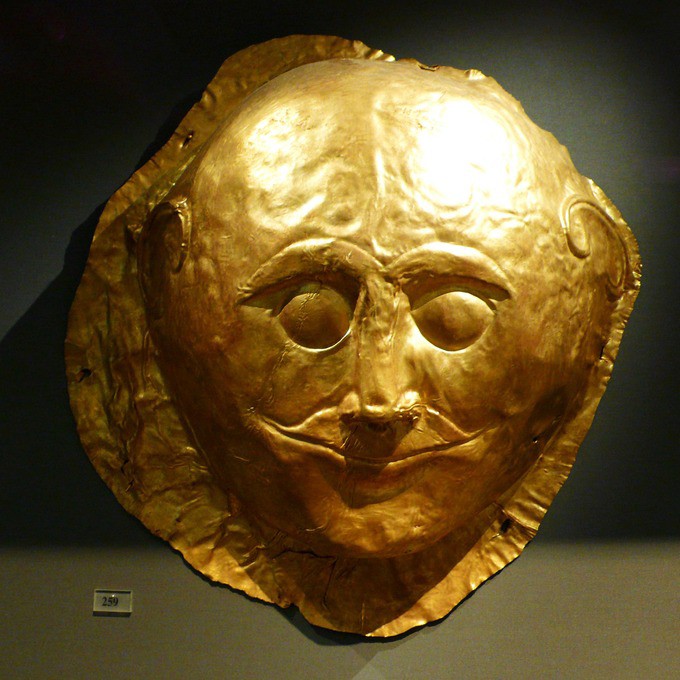
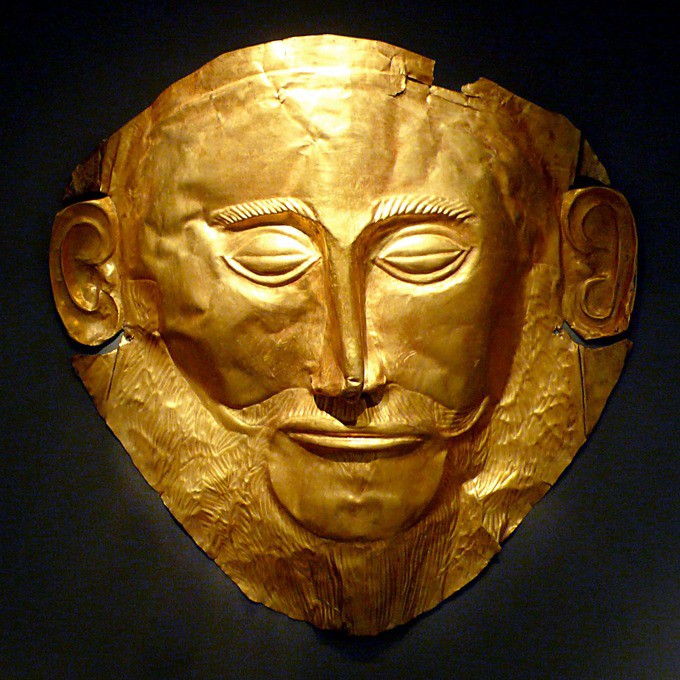
Bronze Daggers
Decorative bronze daggers found in the grave shafts suggest there were multicultural influences on Mycenaean artists. These ceremonial daggers were made of bronze and inlaid in silver, gold, and niello with scenes that were clearly influenced by foreign cultures.
Two daggers that were excavated depict scenes of hunts, which suggest an Ancient Near East influence. One of these scenes depicts lions hunting prey, while the other scene depicts a lion hunt. The portrayal of the figures in the lion hunt scene draws distinctly from the style of figures found in Minoan painting. These figures have narrow waists, broad shoulders, and large, muscular thighs.
The scene between the hunters and the lions is dramatic and full of energy, another Minoan influence. Another dagger depicts the influence of Minoan painting and imagery through the depiction of marine life, and Egyptian influences are seen on a dagger filled with lotus and papyrus reeds along with fowl.
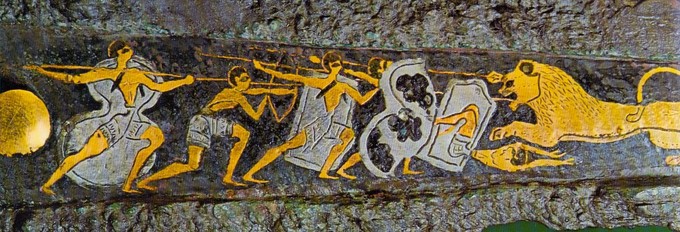
Gold and Silver Rhytons (Drinking Cups)
A variety of gold and silver drinking cups have also been found in these grave shafts. These include a rhyton in the shape of a bull’s head, with golden horns and a decorative, stylized gold flower, made from silver repoussé.
Other cups include the golden Cup of Nestor, a large two handle cup that Schleimann attributed to the legendary Mycenaean hero Nestor, a Trojan War veteran who plays a peripheral role in The Odyssey.
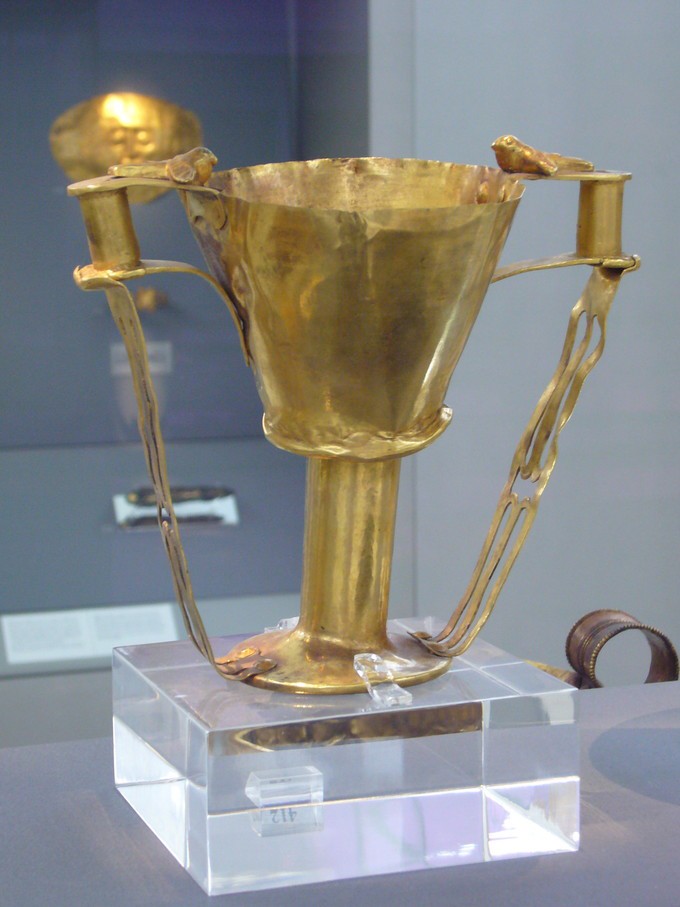
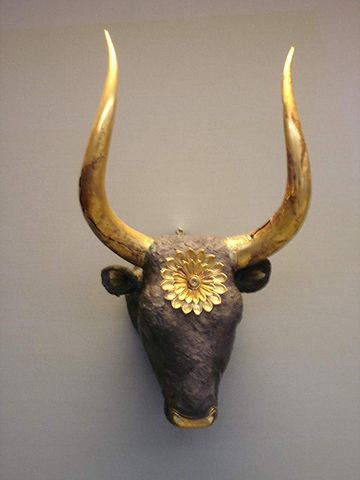
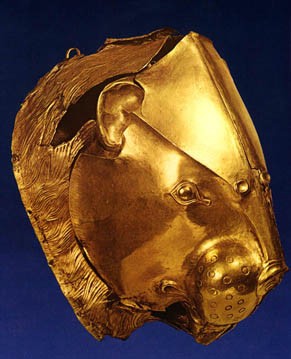
Other Objects
Additional gold trinkets include signet rings that depict images of hunts, combat, and animals, along with other decorative jewelry, such as bracelets, earrings, pendants, and diadems (headbands designating their wearers’ sovereign status).
Bronze armour, including breastplates and helmets, were also uncovered in excavations of the tomb sites.
There are few examples of large-scale, freestanding sculptures from the Mycenaeans. A painted plaster head of a female—perhaps depicting a priestess, goddess, or sphinx —is one of the few examples of large-scale sculpture. The head is painted white, suggesting that it depicts a female. A red band wraps around her head with bits of hair underneath. The eyes and eyebrows are outlined in blue, the lips are red, and red circles surrounded by small red dots are on her cheeks and chin.
Summary
- The city of Mycenae was the center of Mycenaean culture. It is especially known for its protective gateway, the Lion Gate, and the Treasury of Atreus, an example of a tholos tomb. Mycenaean architecture reflects its warring society. A wide, strong wall built from large, roughly cut stones (known as cyclopean masonry ) was one method of protection, as was limited access to citadel sites and well-protected gates.
- Grave Circle A and B, at Mycenae, are a series of shaft graves enclosed by a wall from the 16th century BCE. These gravesites were originally excavated by Heinrich Schleimann, and the grave goods found there demonstrate the incredible skill Mycenaeans possessed in metalwork.
- Gold death masks were commonly placed over the face of the wealthy deceased. These death masks record the main features of the dead and are made with repoussé, a metalworking technique. When compared to other masks, the Death Mask of Agamemnon is most likely a fake.
- Other objects of gold, silver, and bronze have been excavated from Mycenaean gravesites and cities, including armour, jewelry, signet rings, and seals.
Adapted from “Boundless Art History” https://courses.lumenlearning.com/boundless-arthistory/chapter/mycenaean-art/ License: CC BY-SA: Attribution-ShareAlike
The core fortified area of a town or city.
Masonry made of large, square-cut stones.
A simple construction method where two vertical posts support a horizontal lintel, which is placed on top of the two vertical posts.
Constructed by offsetting successive courses of stone (or brick) at the springline of the walls so that they project towards the archway’s center from each supporting side, until the courses meet at the apex of the archway (often, the last gap is bridged with a flat stone).
A metalworking technique in which a thin sheet of malleable metal is shaped by hammering from the reverse side to create a design in low relief.
A large ceremonial drinking cup fashioned in the shape of an animal’s head.

